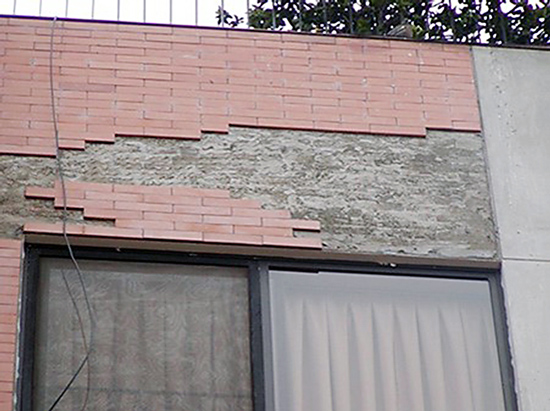Designing Adhered Masonry Veneer
Examples of Damage to Adhered Masonry Veneers
Moisture damage to adhered masonry wall systems can be serious and expensive.

Photo source: FEMA
Delaminated veneer
The photo above shows a thin brick veneer with a portion of the wall delaminated from the structure. The delamination location above the windows compounds potential water problems because water can more easily leak in around the window frame and penetrate the interior walls. This damage is typical of walls that become saturated where freeze-thaw cycles break the bond between the veneer and base coat. Once one brick or stone falls off, it becomes much more likely additional veneer will fall off until the wall can be protected from further moisture infiltration and allowed to dry. Typically spot repairs are not possible for this type of situation, and require removal of the existing lath and scratch coat, repair of the original WRB layers, and application of a new veneer.
When water penetrates a masonry veneer and is allowed to keep a wood substrate continuously wet, sheathing may swell and mold may grow, causing serious structural and health issues. It requires that the exterior be dried and repaired before a cold weather event creates extensive veneer damage, as well as mold removal and repair to or replacement of the damaged wood.
Conclusion
Modern adhered masonry veneer wall design has drawn on the lessons learned over decades of masonry cavity wall design to produce sustainable, long-lasting walls that drain and dry quickly. Rigid insulation between the lath and structural wall is becoming more common as energy standards become more stringent. Advances in building science show that a drainage plane dramatically improves drainage and drying, which helps extend the building’s life, improves energy efficiency by reducing air, moisture and vapor movement through the veneer, and reduces the chances of mold growth.
In order to consistently produce high quality masonry veneer walls, proper installation techniques should be specified. Today’s masonry veneer walls are more complex than they’ve ever been, but proper design and construction will create walls that are better than they’ve ever been.
For additional information and design guidance, consult the MVMA, a division of the National Concrete Masonry Association (NCMA) and the most recognized source for general information, detailing, and installation standards for adhered masonry veneer walls. For more information, visit www.masonryveneer.org.
Steven Fechino is the engineering and construction manager for Mortar Net Solutions. He has more than 35 years of experience in the masonry industry.

| Mortar Net Solutions is the industry leader in moisture management products and systems for masonry, including masonry cavity, single wythe CMU, and adhered masonry veneer walls. It provides innovative solutions that help contractors and designers create beautiful, sustainable structures they can take pride in throughout their careers. www.mortarnet.com |








